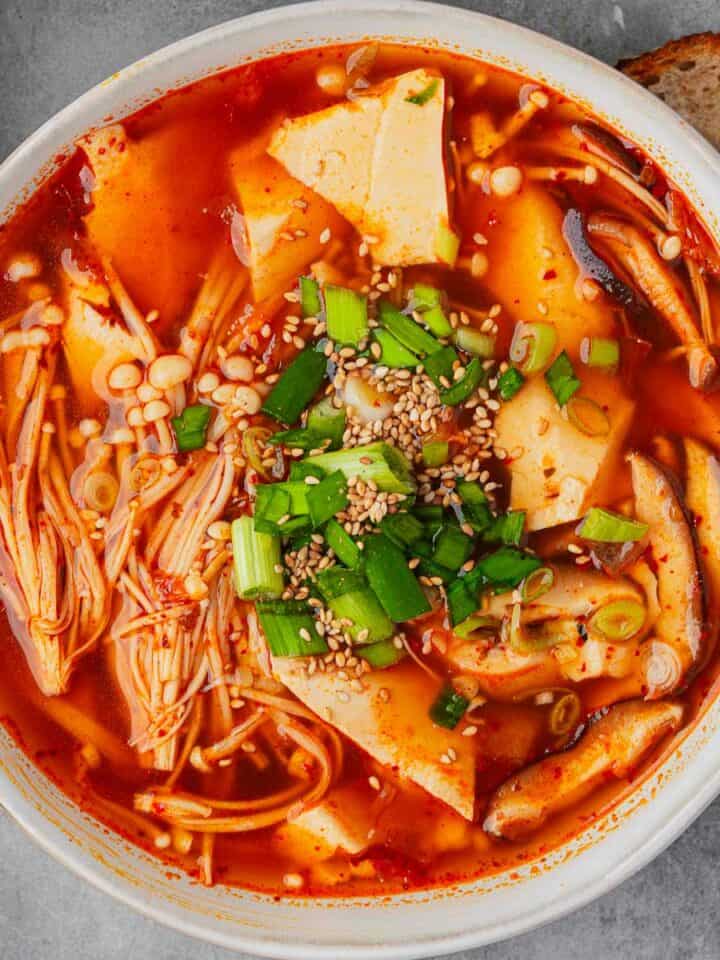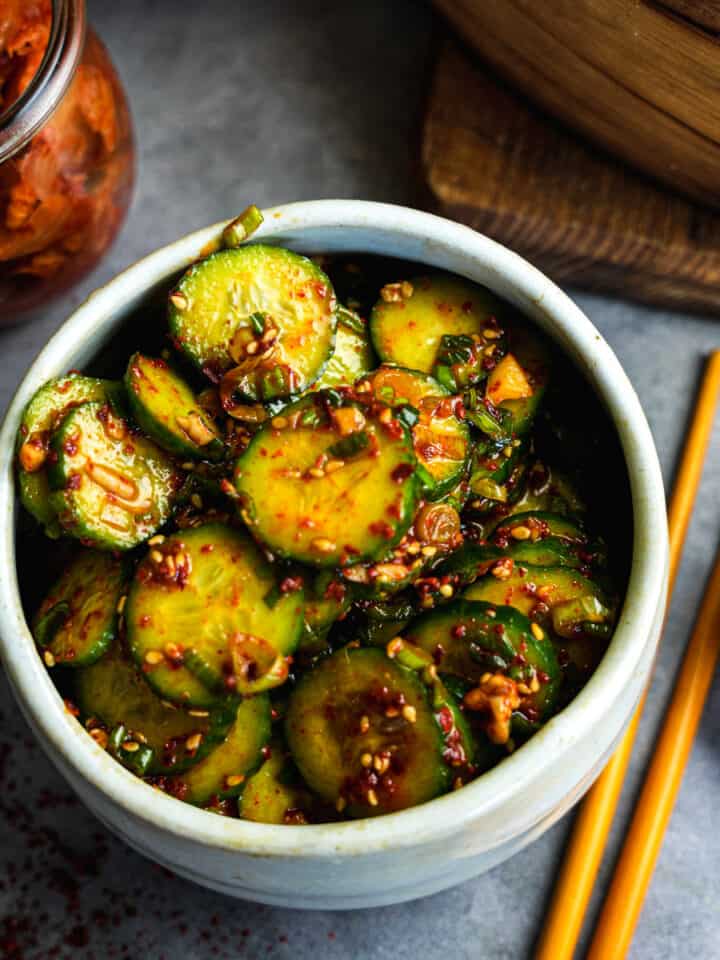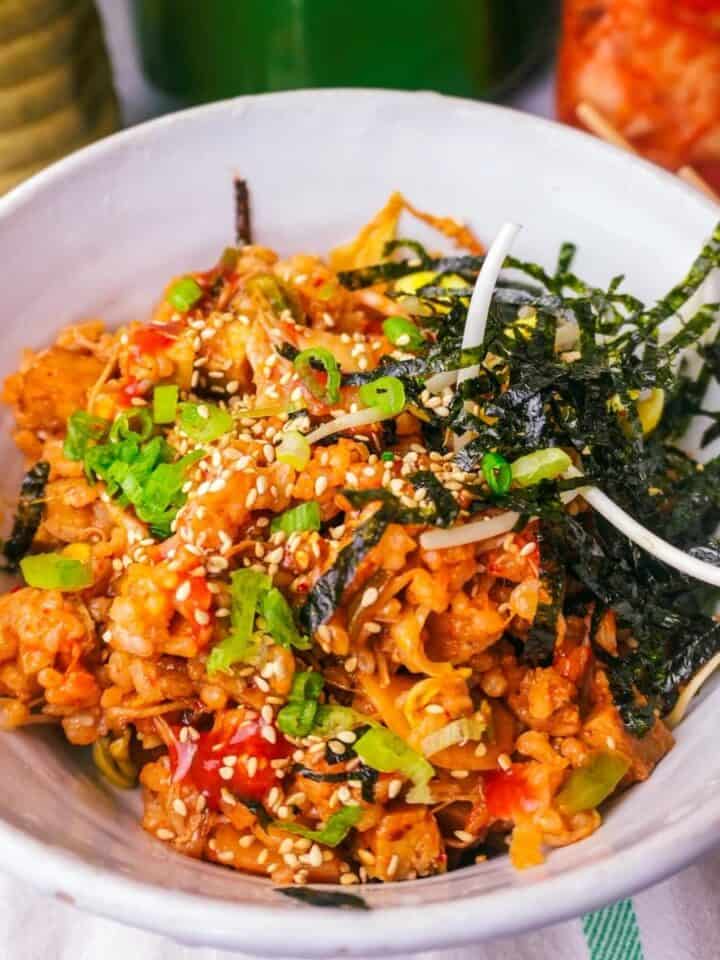*This post may contain affiliate links. Read more »
So, you’re craving that crunchy, saucy magic of Korean fried chicken—but you're also all about the plant-based, good-for-the-planet, and kind-to-the-animals life? Yeah, I’ve got you. This Vegan Korean Fried Chicken Recipe brings all the crunch and sticky, saucy perfection, no feathered friends harmed. Under 30 minutes. A handful of easy ingredients. You’ll be licking your fingers before you even know it.


Enter your email & I'll send it to your inbox. Plus, get great new recipes from me every week!
By submitting this form, you consent to receive emails from Cinnamon Snail.
Here’s the deal: I’m talking classic Korean fried chicken, with that epic crunch and sweet, spicy, can’t-stop-eating-it glaze. But instead of deep frying a poor ol' bird, we’re using seitan—same juicy texture and crispy exterior, minus the guilt and cholesterol. Toss it all in the gochujang sauce, and BOOM! You’ve got yourself a killer dish no one had to be killed for. And if you’re building the ultimate Super Bowl snack lineup, this deserves a spot right next to my vegan fried chicken and buffalo wings dripping with creamy vegan buffalo sauce. Team Crunch, Team Heat, or Team Creamy Buffalo? No wrong answers.
And this isn’t just some “wannabe” fried chicken. This dish delivers—all the crunch, all the flavor, none of the cruelty. Plus, it's so easy to make, you might as well just hand your dog the apron (but seriously, don’t let your dog near the fryer). Grab your cutest apron, and let’s get this crispy, saucy dream on your table ASAP.
Jump to:
🥰 Why you’ll adore this vegan Korean fried chicken recipe
✅ Tested and Approved Worldwide: Like all the vegan recipes I share, this one went through rigorous real-world testing with a team of cooks across different kitchens, climates, and skill levels. The verdict? Crispy, saucy, and totally irresistible—every single time.
🌶️ Flavor That Smacks: Sweet. Spicy. Sticky. Smoky. This spicy sauce does it all—gochujang brings the heat, a little tomato paste adds depth, and every bite is coated in that rich, umami-packed goodness that clings to the crispy seitan like it was meant to be.
✊ Vegan AF: Just like every Korean vegan recipe I do, this one harms no birds and contains no cholesterol. All the crunch and flavor of classic Korean fried chicken, but without being terrible to animals.


👩🍳 Learn to make the BEST vegan Korean food
This 5-day guide to my most popular Korean recipes is 100% FREE, & you'll love the actual heck out of it 🥰
🍗 Vegan Korean fried chicken Ingredients

Seitan
Seitan, also known as "wheat meat," is made from vital wheat gluten. High in protein, chewy in all the right ways, and perfect for soaking up flavor—it gives you the perfect firm-yet-tender bite for this fried chicken. For best results, use my vegan chicken recipe — designed to give you that perfect chicken-like texture. If you're gluten free, swap in firm tofu, soy curls, or use pressed, frozen soft tofu like I do when I make vegan tofu katsu.
High-Heat Cooking Oil
A neutral, high-smoke-point oil like canola, peanut, sunflower, or vegetable oil ensures the seitan crisps up without burning. Peanut oil is a Korean frying favorite (light, stable, super crispy results), but if you’re allergic, stick with sunflower or canola. Olive oil isn't ideal here due to its lower smoke point.
Want to use less oil? This recipe also works great in an air fryer, giving you that crispy texture with a fraction of the oil.
Sriracha
A little heat goes a long way—sriracha not only spices up the plant-based milk mixture but also helps the batter cling better. If the store shelves are looking suspiciously sriracha-free (again), no worries—my sriracha recipe has your back. It’s easy to whip up, and you know exactly what’s in it. If you’re in a pinch, a mix of gochujang and vinegar makes a solid backup plan.
Potato Starch
This is the crispy secret weapon. Lighter than flour, crispier than corn starch—it’s what gives the chicken its signature airy, shatteringly crisp crust. Same reason I use it in my tofu karaage recipe—nothing beats that delicate, crisp bite. If you can’t find potato starch, cornstarch or tapioca starch will work, but potato starch delivers the best crunch.
Gochugaru
These Korean red pepper flakes add a gentle smoky heat and a gorgeous color to the dredge. You can usually find gochugaru at Asian grocery stores, but if you’re out, Aleppo pepper (which I use in a lot of vegan Turkish recipes like kisir and cranberry ezme) or mild smoked paprika with a pinch of cayenne can work as substitutes.
Tomato Paste
A surprising but essential ingredient, tomato paste adds depth, richness, and a bit of natural sweetness to the sauce. A lot of Korean fried chicken recipes take the lazy route with ketchup. But tomato paste is where it’s at—lets us dial in the flavor and skips the weird additives. Plus, it helps the sauce cling better to the crispy coating, so every bite is perfectly sauced.
Gochujang
This fermented red chili paste is the backbone of Korean cuisine, bringing a deep, complex spice that’s sweet, savory, and just the right amount of fiery. No gochujang paste? You can mix miso paste with a little chili garlic sauce and a bit of brown sugar for a similar flavor.
*See the recipe card at the bottom of the page for exact quantities, nutritional info, and detailed cooking directions.
🤯 Variations
Vegan Korean Fried Chicken Banh Mi
Turn this into a game-changing sandwich. Instead of using lemongrass tofu like I usually do with my vegan banh mi, swap in this spicy glazed seitan. Load it up with pickled veggies and a special sauce made from vegan kewpie mayo and hoisin sauce.
Vegan Honey-Chikin
For a sweeter, stickier option, glaze your fried seitan in a mix of soy sauce and apple-based vegan honey. This one’s a delightful balance of sweet and savory for when you want less heat and more honey vibes.
📖 How to make Vegan korean fried chicken
These step-by-step photos and pro tips make this crispy, saucy Vegan KFC impossible to mess up. Need the printable recipe card? Scroll down to grab it.

Step One
Oil Be There for You:
If you’re frying, heat your oil to 375°F (190°C) in a Dutch oven or deep fryer. Air frying? Preheat your air fryer to 375°F (190°C) and lightly oil the basket so nothing sticks.

Step Two
Shred Zeppelin:
Cut or hand-tear your seitan into pieces about 3-4 bites big. If you go too small, you’ll end up with seitan nuggets, which is cool, but not the plan today.

Step Three
Dredge Against the Machine:
Set up a three-part dredging station: One bowl with flour, another with plant-based milk and sriracha whisked together, and a third with a mixture of potato starch, gochugaru, and salt.

Step Four
Crust Me, I’m Delicious:
Coat each seitan piece in flour first, then dunk it in the spiced, curdled non-dairy milk, and then roll it around in the potato starch mix. Press gently to ensure the coating sticks.

Step Five
Fry Me to the Moon:
If frying, cook the pieces in batches for 2-3 minutes per side over medium-high heat until golden and crispy. If air frying, cook for 8-10 minutes, flipping halfway through, until the outside is golden and crackly.
✅ As coated seitan waits to be fried in subsequent batches, sometimes the coating wicks moisture. If necessary, toss it back in the starch before frying it so it’s nice and dry when it hits the hot oil.

Step Six
Sticky Situation:
For the sauce, add the tomato paste, gochujang, maple syrup, tamari, sesame oil, garlic, and ginger into a saucepan. Stir constantly over medium heat for 3-5 minutes until the sauce thickens and bubbles.

Step Seven
Seitanic Glaze:
Toss the fried seitan into the sauce and mix until each piece is fully coated.
✅ Optionally, once coated you can roast the pieces in a preheated oven at 350 degrees for 10-12 minutes to caramelize the sauce onto the wings.

Step Eight
Sesame Street:
Transfer to the serving plate and garnish with a generous sprinkle of black sesame seeds, toasted sesame seeds, and plenty of thinly sliced scallions or garlic chives, and perhaps some radish kimchi.
💡Serving Ideas
If you’re turning this vegan Korean fried chicken into a full meal (which, let’s be real, you absolutely should), here’s how to make it complete.
Start with a steaming bowl of sundubu jjigae—a spicy, bubbling tofu stew that adds warmth and depth to balance the crispy seitan. For sides, you can’t go wrong with a little crunch and tang. Vegan kimchi brings a funky, spicy kick, while Korean carrot salad, oi muchim, or Korean scallion salad perks things up and keeps ‘em in balance. And because no meal should end without something sweet, kkwabaegi—soft, chewy twisted Korean donuts with a light sugar coating—are the perfect way to wrap it all up.
👉Top tips
- Double Dredge for Extra Crunch: After the first coat, dip your seitan back in the wet mixture, and then roll in the dry mix a second time. This double dredging creates a thicker crust, leading to an irresistibly crispy exterior.
- Monitor Oil Temperature Like a Hawk: Keep your frying oil steady at 375°F (190°C). Too hot, and you'll scorch the crust before the inside warms up; too cool, and you'll end up with greasy, soggy pieces. A frying thermometer or countertop deep fryer’s your best friend here.
- Don't Overcrowd the Fryer: Fry the seitan in small batches, giving each piece enough space to cook evenly. Overcrowding drops the oil temperature and leads to uneven, less crispy results. Patience pays off with perfectly fried seitan.
- Rest Before Saucing: Let the seitan sit on a wire cooling rack for a couple of minutes after frying. This brief pause allows the crust to set, and any excess grease to drip off, maintaining its crunch when you toss it in the sauce.
🤷♀️ Recipe FAQs
To make this dish gluten-free, swap the seitan for store-bought vegan chicken or oyster mushrooms, and use a gluten-free flour blend. Also, check that all other ingredients, such as soy sauce and gochujang, are certified gluten-free.
Absolutely! Baking or air-frying are excellent alternatives to deep-frying. Preheat your oven or air fryer to 375°F (190°C), arrange the coated pieces in a single layer, and cook until they're golden and crispy, usually around 15-20 minutes, flipping halfway through. This method reduces oil usage while still delivering a satisfying crunch.
If you deep-fried your seitan, don’t just dump the oil—there are better ways to handle it. Strain it through a fine-mesh sieve or cheesecloth to remove any crumbs, then store it in a sealed container to reuse for another round of frying (as long as it’s still clean and doesn’t smell off). Used oil can also be repurposed for cooking savory stuff like stir-fries, making onion bhaji, bakwan sayur, or tempe mendoan. Because there's savory ingredeints in the coating, don't reuse this poil for making vegan donuts recipes or anything sweet like that.
If it’s past its prime, dispose of it responsibly—never pour it down the drain. Instead, collect it in a jar and toss it in the trash or check if your area has a recycling program for used cooking oil.
Keeping your Vegan Korean Fried Chicken crispy and flavorful even after storing is totally doable with the right approach. Here’s how to refrigerate, freeze, and reheat it.
❄️ Refrigerating:
Store any leftover fried seitan in an airtight container in the fridge for up to 3 days. If possible, keep the sauce separate from the fried pieces to maintain crispiness. If the seitan is already sauced, it will still taste amazing but won’t have quite the same crunch when reheated.
♨️ Air Fryer Reheating:
Preheat the air fryer to 375°F (190°C). Arrange the fried seitan pieces in a single layer in the basket and heat for four to six minutes, shaking the basket halfway through. If the seitan is already sauced, reheat at a slightly lower temperature (350°F or 175°C) for a few extra minutes to avoid burning the glaze.
🔥 Oven Reheating:
Preheat the oven to 375°F (about 190°C). Place the seitan on a wire rack over a baking sheet (this keeps the bottom from getting soggy) and heat for 10-12 minutes until hot and crispy. If the pieces are already coated in sauce, cover loosely with foil for the first five minutes to prevent caramelization from going too far.
⚡️ Microwave Reheating:
If you're in a rush, place the seitan on a plate and microwave it in short bursts of twenty to thirty seconds until warmed through. If the pieces are sauced, cover them with a damp towel to keep them from drying out. While this method won’t bring back the crispy texture, it’s quick and convenient.
For ultimate crispiness, always reheat in the air fryer or oven!
✌️ You'll love these vegan Korean recipes too

Vegan Korean Fried Chicken Recipe
Equipment
Ingredients
The Fried Chicken:
- 1 lb seitan about ⅓ of a batch if you are following my vegan chicken recipe
- 1 cup canola oil or sunflower oil, or vegetable oil
- 1 cup all-purpose flour
- 1 cup unsweetened plant-based milk
- 1 tablespoon sriracha
- 1 cup potato starch
- 2 teaspoons gochugaru
- ½ teaspoon salt
Vegan Korean Fried Chicken Sauce:
- 2 tablespoons tomato paste
- 2 tablespoons gochujang
- ⅓ cup maple syrup
- 2 tablespoons tamari or soy sauce of your preference
- 1 tablespoon sesame oil
- 2 teaspoon garlic minced
- 1 teaspoon ginger grated
To Garnish:
- Black sesame seeds
- Toasted sesame seeds
- Scallions thinly sliced
Instructions
- If frying, preheat oil in a dutch oven on your stovetop, or in a countertop deep fryer to 375°F (190°C). If air frying, preheat the air fryer to 375°F (190°C). Lightly coat the air fryer basket with oil.
- Cut or hand-tear the seitan into natural, 3-4 bite size portions.
- Prepare a dredging station. In one bowl, add the flour. In a second bowl, whisk the plant-based milk and sriracha, then let it sit for a few minutes to curdle. In a third bowl, mix the potato starch, gochugaru, and salt.
- Dredge each piece in the flour, then dip into the curdled milk, ensuring full coverage before dripping off back into the bowl. Finally, coat in the potato starch mixture, pressing gently to adhere. Place the coated pieces on a tray.
- Either fry for 2-3 minutes on each side in batches, or air fry for 8-10 minutes, flipping halfway through, until crisp and golden brown.
- To prepare the sauce, combine the tomato paste, gochujang, maple syrup, tamari, sesame oil, garlic, and ginger in a saucepan. Cook over medium heat, stirring frequently, until slightly thickened.
- Toss the fried (or air-fried) seitan in the sauce until evenly coated.
- Optionally, roast the coated seitan for 10-12 minutes on a parchment paper-lined baking pan at 350 degrees to caramelize the sauce onto the wings, so they set up nice and crispy.
- Transfer to a serving dish and garnish with black sesame seeds, toasted sesame seeds, and sliced scallions. Serve immediately with radish kimchi.
Notes
After frying, let the seitan rest on a wire rack for two to three minutes. This helps the crust set, lets excess oil drip off, and keeps things crispy when you sauce it up.

Enter your email & I'll send it to your inbox. Plus, get great new recipes from me every week!
By submitting this form, you consent to receive emails from Cinnamon Snail.











Marna says
Massive hit with my son and husband.....and I kinda liked it too... NO LEFTOVERS of this gooey, crispy, savory, sweet chicken(less) triumph... Oh I used the frozen soft tofu technique)
Gamani Goonetilleka says
This is an excellent, very easy to follow recipe. Thank you so much 'Cinnamon Snail'...!
Reshyll says
So good that you'll forget it’s not real chicken!! 10/10 would devour again (and again).